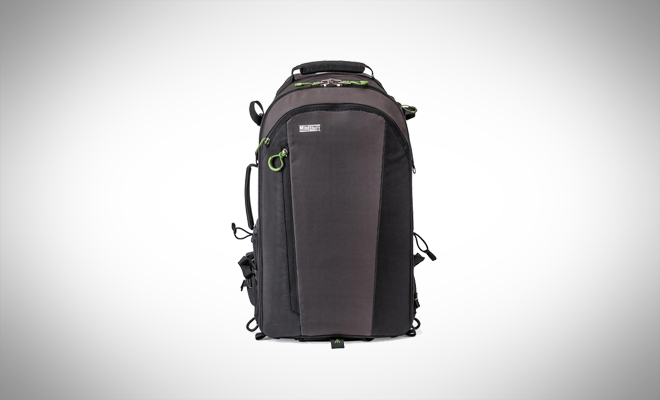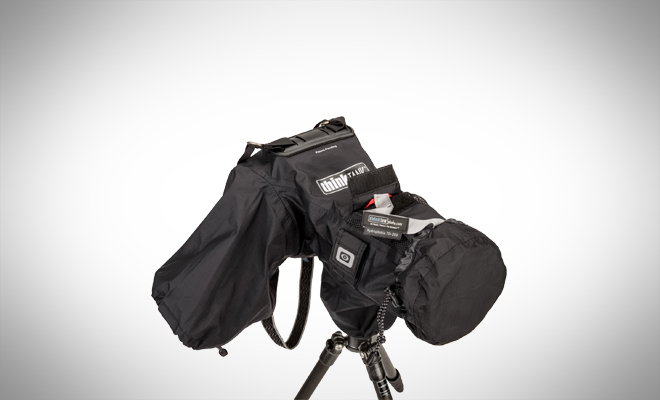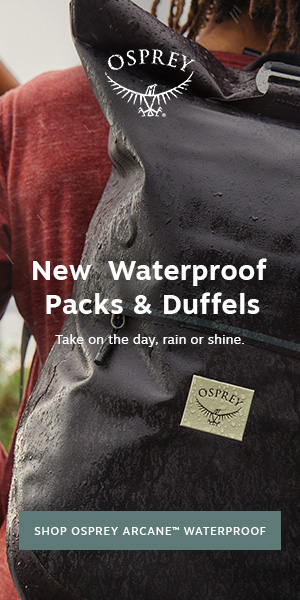Rain, Snow, Humidity or Dust :: Tips to Protect Camera Gear
In order to get great shots, you have to go where the photos are. Sometimes it’s as simple as a stroll round your local neighborhood, but at other times it can involve navigating challenging environments and harsh weather. Wherever you are, protecting valuable camera gear is a priority. So we’ve asked professional photographers to share tips to protect camera gear against rain, snow, humidity and dust…
Daniel Beltrá, Conservation photographer
Protecting the camera when shooting in difficult conditions begins long before you get to your photo location. You have to take care of the gear the moment you set foot out the door!

Pack of Choice
I like to use my MindShift FirstLight 30 backpack when I don’t have to take too much gear with me out into the field. The fabric and coatings used for it provide excellent water resistance.

Hack
But when I know things could potentially turn real hairy, I’ll bring a couple of large heavy-duty garbage bags along, too. Especially if having a Pelican case or similar is not convenient. I will put the camera bag inside the plastic bag and tie the top into a knot if I’m going on a boat, and sometimes I’ve even lined the interior of a camera bag with one of these bags, so that there’s an extra layer on top of that. While this might strike some as a little extreme, doing this absolutely saved an entire shoot for me when a Zodiac boat capsized in the surf as I was coming ashore from the Arctic Ocean to Barrow, Alaska. If it weren’t for the $0.05 garbage bag, my gear and film – this was a while ago – would have sunk in the water and been completely ruined.
“Protecting the camera when shooting in difficult conditions begins long before you get to your photo location. You have to take care of the gear the moment you set foot out the door!”
One other “hack” that I use when I have to check luggage on a flight, I wrap my inflatable mattress pad around my tripod, tighten it with some straps and slightly inflate it, to create a quasi-airbag for it.
Finally, each night when I’m done shooting out in a moist, grungy environment like a rainforest, I’ll clean the gear with a small microfiber/chamois cloth, put it flat in a dry bag, toss in a couple of reusable silica packets, and suck out as much of the air as I can. Overnight this will dry out the gear thoroughly.

“I will put the camera bag inside the plastic bag and tie the top into a knot if I’m going on a boat, and sometimes I’ve even lined the interior of a camera bag with one of these bags, so that there’s an extra layer on top of that.”
Humidity
When I’m traveling for a shoot in very humid environments like the Amazon rainforest, I’ll often keep my gear/camera bag at a warm temperature in a basic Styrofoam cooler. If it takes a long car drive to get to a location, and we use the air conditioning in the vehicle, it’s important to protect the gear from a rapid temperature drop (and subsequent fogging up). I do this by keeping it warm in a cooler. If it starts out warm, it will stay warm. I also use this trick when I’m shooting from ships in the polar regions – I keep my gear outside in a cooler so that it remains cold. So instead of it getting warmed inside the ship and then being fogged up as soon as I come out for a polar bear that’s 10 meters from the deck, walking on an ice floe, I have gear that’s ready to be used at a moment’s notice.
“When I’m traveling for a shoot in very humid environments like the Amazon rainforest, I’ll often keep my gear/camera bag at a warm temperature in a basic Styrofoam cooler.”
Rain
For dealing with rain when I’m shooting, I like the ThinkTank Hydrophobia covers. The ones for the long telephoto glass can be pre-staged to be deployed in less than 30 seconds if I’m quick and/or motivated, while the one for the 70-200mm lens preserves a lot of functionality for the camera with good weather protection while allowing me to be very mobile. In terms of less sophisticated gear, I will often tape or clamp a big golf umbrella to my tripod when shooting in the rain. Sometimes I’ll just wedge it into my backpack also. It’s not a very sophisticated solution to the rain problem, but it works well as long as it isn’t windy.
“In terms of less sophisticated gear, I will often tape or clamp a big golf umbrella to my tripod when shooting in the rain. Sometimes I’ll just wedge it into my backpack also.”

Wind
Wind can be a big problem even if it isn’t raining. I never put a camera bag on the ground if it is windy, *especially* on a beach. Beyond sand, there’s a lot of dust and debris that the wind picks up a foot or so from the surface, so I’m always on the lookout for large rocks, or pieces of driftwood, or tree branches that I can elevate the bag up with. If it is really windy, I will take off the lens hoods, since it is possible in extreme cases for the wind to knock them off. I usually tape down the autofocus selector switches on the lenses and any controls on the camera that I don’t need to change while shooting. When I shoot from open windows in planes, I always take the hoods off to lower the vibrations the wind creates.
Dust
While I do bring a hand-squeezed air blower, I think the best way to beat dust is to change lenses as least often as possible, if ever. This only works if you have enough bodies for all the lenses you’re using, but it does really limit the potential for dust to damage your sensor.

“While I do bring a hand-squeezed air blower, I think the best way to beat dust is to change lenses as least often as possible, if ever.”
Essentials
Among other items I usually bring along is a compact ground sheet made by MindShift, called the Contact Sheet; it gives me a clean, dry surface to put my gear down on wherever I go. I also carry a multi-tool made by Really Right Stuff. It has a lot of functionality for making adjustments or basic repairs to the tripod and camera gear out in the field. Finally, gaffers tape, which I wrap around the poles of my tripod and super telephoto (300mm or more, f2.8) lens hoods. This way I can keep tape at hand when I need it without having to carry a roll with me.

“Among other items I usually bring along is a compact ground sheet made by MindShift, called the Contact Sheet; it gives me a clean, dry surface to put my gear down on wherever I go.”

Chris Brinlee Jr., Storyteller

Pack of Choice
I don’t ever use camera-specific bags (they are bulky, and for what I’m shooting, carry for the adventure is the primary consideration) so my camera just gets stuffed into the top of a backcountry pack when not in use. Currently, I’m using the Cotopaxi Nepal 65L.

Rain
If there’s a chance of inclement weather, I keep the Shell handy – it can be a lifesaver in the rain. When my camera is stuffed in my pack the Shell helps protect my body from anything else (oftentimes climbing gear) that can be rattling around in there with it.
“I also don’t ever use camera-specific bags (they are bulky, and for what I’m shooting, carry for the adventure is the primary consideration) so my camera just gets stuffed into the top of a backcountry pack when not in use.”
Snow
For shooting in snow, it helps to use a weather-sealed body and lens – and when combined with the Shell, you can get solid wet weather protection. Keep a few microfiber cloths handy and in a water/sweatproof pocket. Wipe often. Chances are that there will still be smears, but do what you can. It helps having multiple cloths to rotate through. Your lens is gonna get wet. Just deal with it the best that you can (a lens hood can help too.)
“For shooting in snow, it helps to use a weather-sealed body and lens – and when combined with the Shell, you can get solid wet weather protection.”
Batteries are often problematic to keep dry and warm. I keep mine in a small Hyperlite Mountain Gear drawstring stuff sack (for sweat/weather protection) in my pants pocket (body heat from my thighs is usually enough to keep them warm) but if it’s really cold, I’ll put them in an inside jacket pocket. It can also help to stuff a hot hand in the stuff sack if it’s really cold.

Essentials
Most of my camera carry is from Peak Design. The CapturePRO allows me to keep my camera accessible, but secured and out of the way while moving through the mountains; the Slide strap keeps it secured around my shoulder when shooting.

“The CapturePRO allows me to keep my camera accessible, but secured and out of the way while moving through the mountains; the Slide strap keeps it secured around my shoulder when shooting.”

Camilla Rutherford, Adventure Photographer

Pack of Choice
I always carry my camera gear in a f-stop camera pack with internal camera units (ICUs). They are the best for anyone shooting in outdoor environments and are the best adventure camera packs out there. They work like a normal pack, very comfy and ergonomically designed to carry the weight with little stress on your body. With the changeable ICUs you can choose which one you need depending on what mission you are on. If you are camping overnight and only need to take a basic camera setup but need room for a tent etc. this is possible. If you are skiing and need space for avalanche gear and straps to hold your skis and ice axe, they are there. There are pockets to stash rubbish, easy access to your camera gear, small pockets for CF cards…the list goes on, they’ve thought of everything!
“I always carry my camera gear in a f-stop camera pack with internal camera units (ICUs). They are the best for anyone shooting in outdoor environments and are the best adventure camera packs out there.”

Snow
When shooting on snow and when its deep powder, it can be really tricky to keep snow from getting into your pack. I always stop, stamp out a bit of a platform with my skis and take my bag off, leaving the waist strap on but loose around my middle. I can then open the back flap and get what gear I need out, taking very special care when changing lenses, always holding the DSLR exposed mirror down and away from falling snow and changing lenses as quickly as possible, always taking the lens cap off first and the lens of the camera second; you want to expose the DSLR for as little time as possible.
“When shooting on snow and when its deep powder, it can be really tricky to keep snow from getting into your pack. I always stop, stamp out a bit of a platform with my skis and take my bag off, leaving the waist strap on but loose around my middle.”
I always keep my bag on and closed when shooting in deep snow. Even if you think your skier is far enough away you’ll be surprised how snow can bury or sweep your camera bag away from you faster than you can catch it!
Oh, and if it’s really cold, batteries can drain super fast, so always keep one inside your jacket!
Rain / Snow / Dust
For most extreme conditions I always use a Peak Design Shell to protect my camera. They are great at keeping rain and dust off your gear without compromising ease of use.

Essentials
Of course, like most, I’ve used plastic bags and tape to keep my camera gear dry! But now with companies like Peak Design making awesome rain covers it’s way easier than a makeshift cover. I do always keep a bag cover and the shield in my bag for unexpected rainfall. Also always have a multitude of lens cloths and a pocket blower to clean dust off the lens while on location.
“I do always keep a bag cover and the shield in my bag for unexpected rainfall. Also always have a multitude of lens cloths and a pocket blower to clean dust off the lens while on location.”
If out on an adventure shoot I always take the following: Suncream and insect repellent, a safety blanket, plasters and painkillers, a Leatherman, spare layer, hat and gloves, rain cover for backpack and shield for camera, a compass and a head torch, my mobile phone and Smith sunglasses. These are the basics that pretty much always live in my camera bag. On top of that there is camera gear! It can get pretty heavy…





 Carry Awards
Carry Awards Insights
Insights Liking
Liking Projects
Projects Interviews
Interviews














